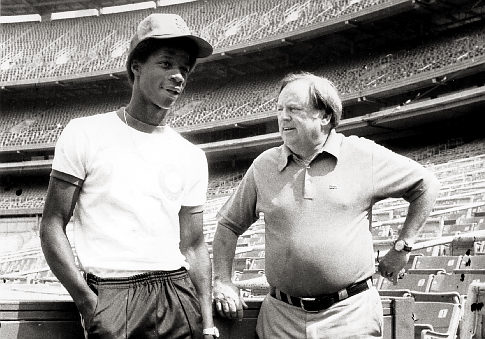
The Magic is Back! That was the Mets promotional slogan in the spring of 1980 after Nelson Doubleday Jr. and Fred Wilpon had purchased New York’s National League franchise. From a business standpoint, the new Met owners bought in at a perfect time. The Mets were in shambles, last place finishers in three consecutive seasons prior to the purchase.
Acting on the advice of several baseball people from outside the organization, the first decision the new owners made was to hire Frank Cashen as their team’s new GM. When the Mets came calling, Cashen, who had earned wide acclaim overseeing baseball operations for the Baltimore Orioles from the late 60’s through the mid 1970’s, was working for baseball commissioner Bowie Kuhn as the administrator of Major League Baseball operations.
Billboards all over NYC proclaimed the ‘Magic Was Back’ off the field, but, as the chart below proves, there was little on-the field magic on the field during Cashen’s first few seasons heading the Mets.

No, for Met fans the early Cashen years brought little baseball magic to Shea. Expecting bold moves to improve the baseball product, Met fans were left scratching their heads when Cashen originally sidestepped the trade route in starting his Met rebuild. In June of 1980, Cashen made his first noteworthy move, a risky move at that, projecting help sometime down the road by signing a raw and talented high school prodigy named Darryl Strawberry. During the same off-season, Cashen signed Doug Sisk and Kevin Mitchell as amateur free agents.
The cautious bow-tied GM, spent much of his early effort working to retool the Met minor league player development system. His evaluation of where the Mets where and where he hoped to take them, crawled into the 1981 season where his only substantial moves came from within, the elevation of Hubie Brooks and Mookie Wilson to the big team in Flushing.
Cashen quietly continued to utilize the draft as a major tool in plotting improvement signing Lenny Dykstra in the 13th round of the 1981 draft. 1981 was the first time Cashen put his big toe in the player trading market bringing in fan-favorite Dave Kingman for a second round with the team as a slugging bat in the line-up.
It was in 1982 when Cashen made two moves that created a collective stir in Metsland. With one bold strike, a move than never panned out quite like Met fans hoped, but an important symbolic maneuver that signaled to the fan base the Mets were serious about their rebuilding efforts, Cashen traded for and signed Cincinnati Red slugger George Foster to play for the Mets.
After buoying the hopes of Met fans, Cashen became the target of ire two weeks later when he shipped Met fan favorite Lee Mazzilli our of town for two pitchers, Ron Darling and Walt Terrell. Darling would later become a mainstay of the Met staff, an All-Star and critical piece in their World Series Championship run. Terrell won 20 games and lost 21 in his last two seasons as a Met and was an innings eater who pitched 215 innings in their turnaround season in 84. More importantly, Cashen traded Terrell for Howard Johnson in the off-season following the 1984 campaign.
With his eye always focused on young talent, Cashen continued to scour the baseball landscape looking for talent through the draft. In June of 1982 he signed future ace pitcher Dwight Gooden as a first round pick and Roger McDowell in the third round.
Cashen continued his reconstruction project in 1983 signing Rick Aguilera in the third round of the draft. Even though the Mets failed to top a .420 winning percentage for the seventh consecutive year, Cashen’s trades for Keith Hernandez from the Cardinals and Sid Fernandez from the Dodgers added the fine china to the table Cashen had meticulously been setting in his early years as GM for the Mets.
Once the Mets turned their win/loss record upside down in 1984, fans flocked back to Shea, and Cashen’s GM decisions shifted. The Met GM was no longer table setting for future success but cherry picking and looking for main course dinner entrees to take the Mets over the top. Enter Gary Carter.
With the 2014 season coming to a close, a new season starts, the annual Sandy Alderson flash mob slam. Yes, the patience of many Met fans is wearing thin and Alderson stands front and center as the target of their ire.
I for one have not lost hope that positive change is underway. I can’t help but recognize the parallels between the early work of Alderson and his front office team and that of Cashen during the beginning of his stay as the Met G.M. The work overhauling the minor leagues, the emphasis on the draft, the retooling of the young pitching staff, the willingness to trade popular current pieces for projected future success are all Alderson moves utilized by Cashen long ago.
As I see it, the jury is still out on Sandy’s Met rebuild, and this off-season is critical. When the groundwork was laid in the early 80’s, Cashen stepped out of his comfort zone and used free agency and trades to procure the main ingredients for a championship dish. Sandy Alderson has failed to do that as of yet. If and how he does will be the difference maker that determines Alderson’s legacy as a GM of the Mets.

From what I witnessed yesterday at Instructional’s in Port St. Lucie, the magic can be back if the organization handles their talent right. There are some real good ball players in the Mets Farm System. I left very excited about the future, it may take a few years, but these young kids are good and are hungry to help the big club.